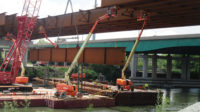While contractors were optimistic that costs would stay low and contribute to a strong fiscal 2020 as recently as January, the coronavirus pandemic has upended construction just as it has every other industry.
“It’s becoming clearer day by day that construction will be negatively affected for months by shortages of key workers or key materials,” says Ken Simonson, chief economist of the Associated General Contractors of America.” Firms had already begun sending reports to the trade group about their experiences dealing with the fast-spreading virus.
Some reports already included delayed delivery of drywall, glass, steel, HVAC and electrical equipment from China as well as curtain wall from Italy.
Impacts at Hand
Contractors already are claiming force majeure—a contractual situation due to uncontrollable circumstances where an owner is responsible for losses or impact on schedule. While delays from U.S.-based suppliers have not yet been reported, many contractors fear it’s only a matter of time until those shortages begin to be felt as work stops in factories employing more than 250 people and production lines shut down in everything from steel mills to glass factories.
“Shortages of key workers, such as the crane operator who has to self-quarantine, or the ready-mix company that can’t deliver enough loads for a big pour,” will occur, Simonson said. As in other industries, those shortages in construction could last for months, depending on how long the federal government advises businesses to keep plants closed.
In Kansas City, Mo., architect, engineer and contractor Burns & McDonnell reported no projects delayed or shut down as of March 16, but cautioned that anything could change at any time. “We have a resilient business continuity plan designed to navigate the effects of this pandemic,” CEO Ray Kowalik said in a statement.
Design firms have bolstered IT capabilities to allow employees to work from home, conduct virtual meetings and have secure file-sharing methods, but those methods of mitigating contact do not bring much relief on jobsites that require lots of personnel.
For building owners, the loss of income from other business lines and the constantly changing economic situation may force them to rethink planned projects or even dial back existing ones. Baseball games are now delayed at Globe Life Field, with other events already canceled.
“Longer term, there may be a wide range of owners that can’t afford or no longer see the need for structures they had been planning,” Simonson says.
Clouds Looming
The price of crude oil has fallen below $30 a barrel at ENR press time on March 17, and other commodity prices are falling with it. That trend would normally be good for the bottom lines of contractors and owners, but with so much accompanying uncertainty, many may still choose to move cautiously.
On March 15, the Federal Reserve cut its benchmark interest rate to zero and launched a $700-billion quantitative easing program of asset purchases, all emergency moves. The Fed also cut the rate of emergency lending for banks by 125 basis points to 0.25%.
These moves would generally be positive for developers and construction lenders, but the uncertainty of how long the coronavirus remains a threat clouds even the effect of those moves.





Post a comment to this article
Report Abusive Comment